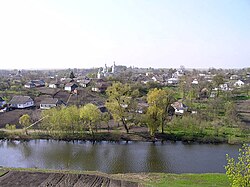Korets
|
Korets Корець Korzec |
||
|---|---|---|

General view of Korets
|
||
|
||
| Coordinates: 50°37′02″N 27°10′39″E / 50.61722°N 27.17750°ECoordinates: 50°37′02″N 27°10′39″E / 50.61722°N 27.17750°E | ||
| Country Oblast Raion |
Ukraine Rivne Oblast Korets Raion |
|
| First mentioned | 1150 | |
| Population (2001) | ||
| • Total | 8,649 | |
Korets (Ukrainian: Корець, Russian: Корец, Polish: Korzec, Yiddish: קאריץ Koritz) is a city in the Rivne Oblast in Ukraine. The city is located on the Korchyk river, 66 kilometers to the east of Rivne. It is administrative center of the Korets Raion. In 2001 the population of Korets was 8,649.
Known since 1150 as Korchesk, Korets was fortified by Prince Theodor Ostrogski in the late 14th century. At that time, the town was part of the Grand Duchy of Lithuania. Between the 15th and 17th centuries it was the seat of the princely House of Korets that issued from Duke Narimantas of Volhynia. After the death of the last Prince Korecki in 1651, it passed through inheritance to the junior line of the House of Czartoryski and became its main seat until the line died out in the early 1800s. The Korets porcelain plant was established by Józef Klemens Czartoryski in 1783. It was managed by French brothers Francois and Michel de Mezer of Sevres. Its products were famous across Poland. The plant burned in 1797, was rebuilt in 1800, and operated until 1832. Furthermore, Prince Jozef Czartoryski opened here a manufacture of cloth sash, popular among Polish – Lithuanian szlachta.
Following the 1569 Union of Lublin, Korets became part of the Kingdom of Poland, where it remained for over 200 years, until the Partitions of Poland. The town then belonged to the Russian Empire, returning to Poland in the interbellum period. In the Second Polish Republic, Korzec, as it was called, was part of Rowne County, Volhynian Voivodeship. Most of its population was Jewish, with Polish and Ukrainian communities. In the summer of 1943, local structures of the Home Army were destroyed by the Germans.
...
Wikipedia


